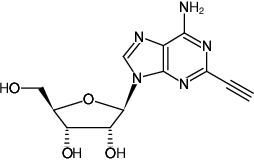2-Ethynyl-adenosine
| Catálogo Nº | Apresentação | Preço (R$) | Comprar |
|---|---|---|---|
| CLK-N005-1 | 1 mg | Sob demanda | Adicionar ao Carrinho |
| CLK-N005-5 | 5 mg | Sob demanda | Adicionar ao Carrinho |

For general laboratory use.
Envio: shipped at ambient temperature
Condições de armazenamento: store at -20 °C
Short term exposure (up to 1 week cumulative) to ambient temperature possible.
Validade: 12 months after date of delivery
Fórmula molecular: C12H13N5O4
Peso molecular: 291.26 g/mol
Pureza: ≥ 95 % (HPLC)
Forma: solid
Solubilidade: up to 4.0 mM in 1 x PBS
Formulários:
mRNA poly(A) tail synthesis monitoring[1]
Descrição:
2-Ethynyl-labeled adenosine (2-EA) can be used to measure de novo mRNA poly(A) tail synthesis in proliferating cells. 2-EA is cell permeable and incorporates into nascent mRNA transcripts both transcriptionally by RNA polymerase I,II and III and posttranscriptionally by poly(A) polymerase instead of their natural analolg adenosine.
The resulting ethynyl-functionalized RNA can subsequently be detected via Cu(I)-catalyzed click chemistry that offers the choice to introduce a Biotin group (via Azides of Biotin) for subsequent purification tasks or a fluorescent group (via Azides of fluorescent dyes) for subsequent microscopic imaging[1].
Presolski et al.[2] and Hong et al.[3] provide a general protocol for Cu(I)-catalyzed click chemistry reactions that may be used as a starting point for the set up and optimization of individual assays.
Produtos relacionados: 2-Ethynyl-ATP (2-EATP), #CLK-NU-004 5-Ethynyl-uridine (5-EU), #CLK-N002 Copper (II)-Sulphate (CuSO4), #CLK-MI004 Tris(3-hydroxypropyltriazolylmethyl)amine (THPTA), #CLK-1010 Sodium Ascorbate (Na-Ascorbate), #CLK-MI005
Referências selecionadas:
[1] Curanovic et al. (2013) Global profiling of stimulus-induced polyadenylation in cells using a poly (A) trap. Nat. Chem. Biol. 9 (11):671.
[2] Presolski et al. (2011) Copper-Catalyzed Azide-Alkyne Click Chemistry for Bioconjugation. Current Protocols in Chemical Biology 3:153.
[3] Hong et al. (2011) Analysis and Optimization of Copper-Catalyzed Azide-Alkyne Cycloaddition for Bioconjugation. Angew. Chem. Int. Ed. 48:9879.
